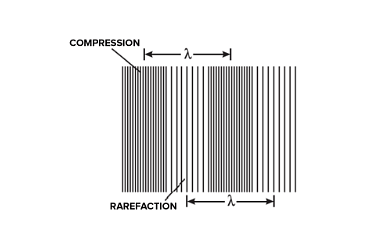Describe with the help of a diagram, how compressions and rarefactions are produced in air near a source of sound.
Solution and Explanation
Compression:
This refers to the section of the medium where particles move closer than their normal separation distance.
Rarefaction:
This pertains to the portion of the medium where particles move apart to distances greater than their normal separation distance.
Explanation:
When a tuning fork vibrates, its prong compresses the air particles immediately in front of it. As a compression wave propagates horizontally through the air, the air particles undergo periodic motion along the horizontal direction.
In a longitudinal wave, if the particles of the medium vibrate horizontally, the disturbance also travels horizontally. Moreover, this wave travels in the form of compressions and rarefactions.
The wavelength is the distance between the centers of two consecutive compressions or rarefactions.
The velocity of the longitudinal wave is determined by:
\(V=fλ\)
Where \(f\) is the frequency and \(λ\) is the wavelength,
Top Questions on Production of Sound
- What is sound and how is it produced?
- CBSE Class IX
- Science
- Production of Sound
Questions Asked in CBSE Class IX exam
- “To hear any flute is to be drawn into the commonality of all mankind.” Why does the author say this?
- CBSE Class IX
- Kathmandu
A driver of a car travelling at \(52\) \(km \;h^{–1}\) applies the brakes Shade the area on the graph that represents the distance travelled by the car during the period.
Which part of the graph represents uniform motion of the car?- CBSE Class IX
- Graphical Representation of Motion
- Match the phrases in Column A with their meanings in Column B.
A B (i) broke out (a) an attitude of kindness, a readiness to give freely (ii) in accordance with (b) was not able to tolerate (iii) a helping hand (c) began suddenly in a violent way (iv) could not stomach (d) assistance (v) generosity of spirit (e) persons with power to make decisions (vi) figures of authority (f) according to a particular rule, principle, or system - CBSE Class IX
- My childhood
ABC is a triangle in which altitudes BE and CF to sides AC and AB are equal (see Fig). Show that
(i) ∆ ABE ≅ ∆ ACF
(ii) AB = AC, i.e., ABC is an isosceles triangle.

- CBSE Class IX
- Some Properties of a Triangle
- The author speaks both of people who were very aware of the differences among them and those who tried to bridge these differences. Can you identify such people in the text?
- CBSE Class IX
- My childhood
Concepts Used:
Sound
Sound is a vibration that propagates the mechanical wave of displacement and pressure, through a medium can be of any matter. In other words, the sound is the thin line between Music sound and Noise.
Types of Sounds:
Sound can be divided into two types depending on its frequency. The following are:-
Infrasonic Waves:
- Infrasonic waves have a frequency lower than 20 Hz. Since it is below the human hearing range, it is inaudible to humans.
- However, several other living organisms use these waves to communicate, whales, sharks, elephants, hippopotamus, etc. these waves are also used in the scientific field, it is used to study upcoming earthquakes, volcanic eruptions, human heart rates, rock formation stages, etc.
Ultrasonic waves:
- Ultrasonic waves have a frequency higher than 20 kHz. Since it is above the human hearing range, it is inaudible to humans.
- These waves are used in the scientific field, it is used to study human heart rates, to take sonograms, navigation of directions, imaging things, uniform sample mixing, communication, testing of samples, etc.